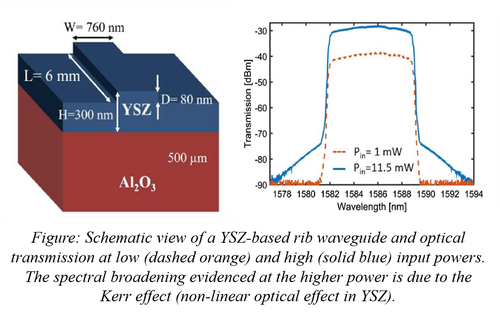Contacts: Thomas Maroutian and Sylvia Matzen
Current PhD students: Ana-Maria Statie, Pablo Bedoya Rios, Faryal Talib, Nihal Benabdelkader
Former PhD students: Guillaume Marcaud, Alicia Ruiz-Caridad, Ali El Boutaybi
Context:
Despite major innovations in recent years, the functionalities of photonic chips remain limited by the intrinsic properties of silicon such as its indirect gap and its centro-symmetrical structure. The integration on silicon of crystalline oxides, which present a great diversity of original properties, would make it possible to extend the functionalities of the devices in various fields of applications such as telecommunications, detection or quantum optics to name a few.
The transition between the crystal lattice of silicon and these oxides, necessary for good quality epitaxial integration, is made possible by buffer layers such as Yttria Stabilized Zirconia (YSZ). Although this oxide is already recognized for its use in batteries as an electrolyte or as a thin buffer layer on silicon, this material and other doped Zirconium oxides remain relatively unexplored in integrated optics.
Project:
The general purpose is to investigate the potential of crystalline doped Zirconium oxides (such as YSZ) for silicon photonics applications. We aim to fabricate low loss photonic devices, to demonstrate potentially high nonlinear optical properties of such oxides, and to develop optical amplification. For that purpose, doped zirconium oxides are epitaxially grown by pulsed laser deposition (PLD) on sapphire or silicon substrates and structurally characterized by X-ray diffraction (XRD) and transmission electron microscopy (TEM). The optimized materials are then patterned into photonic devices, using various steps of lithography, deposition and etching performed in cleanroom. The photonic devices are characterized optically in the telecom wavelength range (1.3-1.5 µm), including measurements of propagation loss, nonlinear effects and optical amplification.
Highlights:
The growth by PLD of YSZ thin films has been studied and optimized on sapphire substrate. XRD and TEM studies have revealed that it is possible to control the growth direction and maintain an excellent crystalline quality below a critical thickness of 350nm. By developing an innovative process in cleanroom, YSZ-based photonic devices, such as rib waveguides and grating couplers have been designed, fabricated, and characterized. Propagation loss as low as 2 dB/cm has been demonstrated, similar to propagation loss in usual silicon waveguides. These very promising results have been published in 2018 in Physical Review Materials [1], and opened a route for the integration of functional oxides in silicon photonics.

Nonlinear all-optical technology is an ultimate route for the next-generation ultrafast signal processing of optical communication systems. New nonlinear functionalities need to be implemented in photonics, and complex oxides are considered as promising candidates due to their wide panel of attributes. In this context, yttria-stabilized zirconia (YSZ) stands out, thanks to its ability to be epitaxially grown on silicon, adapting the lattice for the crystalline oxide family of materials. We have reported for the first time a detailed theoretical and experimental study about the third-order nonlinear susceptibility in crystalline YSZ. We experimentally measured the effective Kerr coefficient of YSZ, in agreement with the theoretical predictions, and comparable with the one of silicon nitride, which is already being used in nonlinear optics. These results, obtained in collaboration with Université de Pau et des Pays de l’Adour (Pau, France) and Institut d’Optique Graduate School (Palaiseau, France), were published in 2020 in Photonics Research [2] as a pioneering step toward the implementation of functional oxides for nonlinear optical applications.

The substitution of Yttrium by rare-earth elements (Erbium, Thulium…) offers new optical and reconfigurable properties for on-chip photonic integrated circuits, in particular for the fabrication of active photonic structures showing optical gain. Preliminary results have been obtained and already published [3, 4]. Multilayers of Erbium-doped YSZ have been deposited on sapphire and exhibit a strong photoluminescence (PL) at 1530 nm wavelength [3]. A guided PL emission has also been evidenced in the near infrared region in hybrid structures of SiN/Er-doped YSZ waveguides [4]. The study of optical gain in these hybrid structures is ongoing.

Publications : Here
Fundings :


Collaborations:
